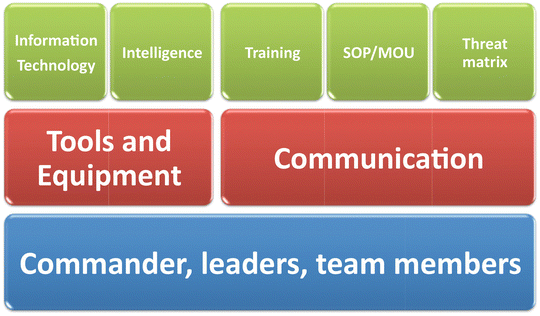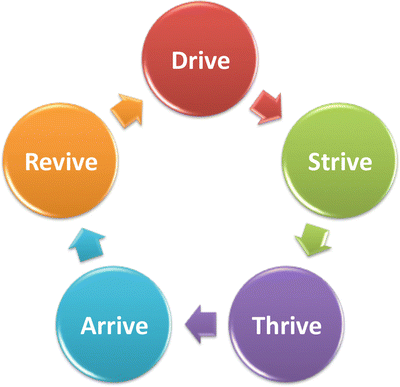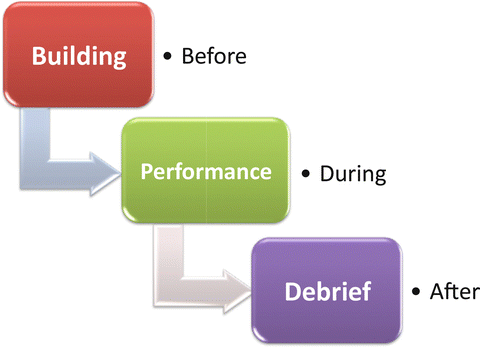Fig. 27.1
Crisis characteristic
First, confusion is a hallmark of crisis in that there is information and plan disarray, and crises are unclear in nature and course. Confusion impedes obtaining useful and timely information regarding current events. Second, all crises are imbued with risk which may oppose decisive action. Third, since crises are unexpected, they represent a unique and transient concatenation of circumstances, individuals, and locations, establishing a time sensitivity to their solution. When the crisis involves individuals, the crisis may be characterized as time competitive in that the commander needs to maintain the initiative to reach a rapid and successful resolution. Fourth, even when individuals are not the focus of the crisis, there is a human element centered about the responders and victims that must be acknowledged both during and after the crisis is resolved. Fifth, tactical crises powerfully tend to degenerate toward chaos. Effective teams that are integrated into highly functional systems provide the main mechanism to resolve, but not prevent, critical incidents.
Key Elements of Team Dynamics
Even great leaders cannot craft a superb team if the membership is not up to the task. Membership selection is therefore a key event. There is no single metric that will allow a leader to select ideal team members, but a montage of metrics may well serve to do so [11]. Performance metrics that highlight dedication, drive, and aptitude are useful. Physical fitness assessment is another required element when selecting team members for high-speed team such as SWAT teams [12]. The Cooper Institute Fitness Assessment is a commonly used instrument that has been validated as a predictor of a police officer’s ability to complete patrol duties [13]. However, it is less rigorous than measures employed by US Military Special Operations Teams during member selection and performance review. The latter is a key element that is often overlooked, especially in low-activity (i.e., infrequent SWAT team callouts) regions with dually tasked individuals (patrol officer and SWAT operator, firefighter and urban search and rescue operator, etc.) [14]. Instead, iterative assessment is required for team membership. The military special operations teams have the benefit of continual assessment during deployments as well as between deployment training sessions. Indeed, fitness is part of the job description, and time is allotted for fitness maintenance; no such time is generally allotted for civilian special response team members, and such activities are generally not funded. Fitness is therefore the responsibility of the team leader and team members.
Command and Control
The notion of command overlaps with the concept of control. It is useful to distinguish the two as they are not necessarily embodied in the same individual. Command identifies that the individual can (by virtue of their position, power, and authority) compel compliance. Control implies that the individual is providing direction but cannot compel adherence to their plan. Control is enabled by persuasion, influence, and example. Both command and control are inextricably intertwined in critical incidents [1]. Indeed command is said to have delegated authority, while control is said to represent perceived authority. Military parlance denotes the two as C2. Team commanders may be selected on the basis of perceived or demonstrated skill in related or unrelated domains. Real-world experience (immersive, direct) is always preferable to tenure-based (inferred) experience [15, 16]. Commanders and team leaders need to maintain the initiative during critical incidents so as to direct the interrelated events necessary for resolution. This task is optimized by crafting an appropriate command and control architecture.
Command and Control Architecture
Since critical incidents are temporary, command and control architecture is similarly temporary. Embracing the need to have a single command entity, such temporary architecture should be explicitly constructed to be directed by a single entity. Such constructs may be typified by Emerging Multi-Organizational Networks (EMON) which consist of task-oriented and mission-specific collaborations of individuals and resources [17, 18]. EMON structure defines lines of authority (effectively but not necessarily equitably), distributes power, and efficiently allocates resources for critical incident resolution, broadly grouped into the following eight domains:
1.
Common technology and procedures.
2.
Modular development of teams and responses.
3.
Unified command structure.
4.
Plan in advance for every major and predictable type of critical incident the team might face, as well as recovery plans for initial plan failure or inefficacy during an incident.
5.
Maximum number of supervised individuals.
6.
Identify critical incident relevant facilities.
7.
Resource management plans for all teams.
8.
Integrated communication systems.
Communication systems pose a unique challenge to EMON structure as these events oftentimes involve disparate elements, integrating different communication systems and protocols. The most effective team is likely to fail if the parts are unable to communicate in a timely and effective fashion. One such example is the Area Command Team (ACT) concept of the LA County Sheriff’s office. Following the 1992 Los Angeles riots, the LA County Sheriff’s Department completed an in-depth review process that evaluated the logistics behind their successful and unsuccessful resource management that laid the foundation for modern management paradigms. The ACT concept has articulated structures that parallel how SWAT teams function today including a central command with linked field command coupled with teams with operational authority in response to conflict exigencies that depart from the anticipated course. Such a structure is readily adapted to nonpolice command team structures as well. Effective ACTs require resources to be funded and allocated for team use.
Resources
Resource management includes acquisition, cataloging, maintenance, revision, funding, allocation, mobilization, and deployment of needed elements in a fashion designed to swiftly resolve the critical incident. Therefore, resource management includes not only material but human resources as well. Since critical incidents often span more than one responder type (i.e., police, SWAT, EMS, fire), a system for resource management is essential. Resources can be housed at a single depot location or mobilized from various staging locations as needed. Both approaches work and selection of the most appropriate method should be influenced by local dynamics. An oft underappreciated aspect of resource management is team member development [9]. This includes ongoing training and advanced training of existing members as well as recruitment and education of new members. A plan for ongoing team development to include succession planning would also be appropriately housed under resource management. Regular review of all of the above elements helps teams and their administrators determine how best to manage all aspects of their teams.
Review Process Including Logistics
Developing and maintaining a review process that evaluates team construction, resource allocation, and coordination within an agency as well as with other agencies should be distinct from the review process that evaluates team performance during critical incident deployment. The first relates to funding and the mechanics of relationship development, while the latter addresses real-world implementation of what the former has put in place. An essential element of the review process is to identify the presence of gaps in logistics for critical incident response and coordination. A templated approach to the review will support a regular process and should be constructed to identify elements that are missing and deficient in number or extent, as well as those that are ideal. Best practices that may be exported or taught to other agencies should be identified and should be considered for dissemination at multiple levels. Agency templates should have broad overlap of general domains (Fig. 27.2). The domains may include, but are not limited to:


Fig. 27.2
Agency template domains
1.
Commander, leader(s), and team members (number, training, and capabilities)
2.
Tools and equipment
3.
Communication (equipment and protocols) and mobile platforms
4.
Computer and information technology infrastructure and architecture
5.
Intelligence gathering/analysis and dissemination
6.
Training time and scope
7.
Standard operating procedures and memoranda of understanding with relevant agencies, policies, and protocols
8.
Threat matrix-driven team deployment triggers and succession planning
The review process and logistical evaluation are thorough and redundant plan that optimizes strategy and resource allocation to ensure that all essential elements are available and accessible during critical incidents.
Transactive Memory
Transactive memory is a characteristic of successful teams that results from iterative training with the team as a whole [19]. Each team member understands their role as well as that of the other team members. Integrated training exploits the expertise of each team member and makes it clear to the other members of the team. An external reviewer might note smooth performance without significant need for communication to address challenges. Such observations characterize special operations teams that continually practice, train, and deploy together. Civilian teams rarely do so to such a degree, and many elements that are mobilized during a critical incident are accustomed to working alone rather than as part of a dynamic team (i.e., patrol officer who is the first responder to an active shooter scenario). Thus, the cultivation of transactive memory must be a fundamental goal of team training and may change throughout the life cycle of a team.
Life Cycle of Teams
Teams are characterized by standard time frames during their lifespan (Fig. 27.3). Prior to the team’s creation, there is a perceived need for such a team that may be termed the “drive” for team creation. Indeed without such a need, the driving force for team assembly is notably less focused leading to a team that is diffuse in targeting and broad in scope. Lack of focus may compromise training and utilization leading to a team that is ill equipped to address the mission at hand. Once assembled, critical incident response teams “strive” to achieve a high level of performance that is task oriented and mission specific. It would not be appropriate for a SWAT team to prepare for firefighting, for example. Once assembled, trained, and deployed, teams “thrive” and refine their membership, skills, and capabilities. It is during this period that teams refine their mission. Some teams expand and others contract depending on local need and capability. Having done so, teams achieve a level of competency and may be characterized as having “arrived,” demonstrating organization that reflects a competency-based hierarchy. After a period of time and without a new drive, teams may atrophy, losing the crispness of their skills sets and decreasing the rate of new skill acquisition. Such events may reflect the aging of team members, lack of utilization as the original drive has been eliminated or decayed, or leadership failure as well as a host of other influences including deficient funding for training. Team salvage hinges on entering a phase of “revival,” relying on a new entry into the life cycle demonstrated in Fig. 27.3. Such driving forces often represent changes in the threat matrix or dynamic, changing environmental demographics, shifts in leadership priorities, or new team leadership or membership. One way to help support team dynamics is to evolve a stepwise plan for team management that addresses team building, performance, and debriefing (Fig. 27.4).



Fig. 27.3
Team life cycle

Fig. 27.4
Stepped plan for team management
Team Building (Before)
Team building is both an internal and external process. The internal aspect involves progressive team training for different scenarios so that team members become facile at their tasks and are prepared to address the spectrum of challenges that they might face. Besides supporting the development of transactive memory, teams also develop an esprit de corps, especially in teams where each team member is directly responsible for the lives of the other members [20]. Accordingly, a sense of personal responsibility characterizes well-functioning teams. These intense relationships generally do not occur within disparate teams. Accordingly, specialty teams should prepare to interface and work with other teams, rendering team building an external process as well. Regional exercises that bring disparate teams together and drive EMON evolution followed by a performance review support this goal. Citywide mock disaster exercises are prime examples of this kind of team building. Since details are easily lost, trained observers as well as digital recording of events for post hoc critique might identify opportunities for performance improvement.
Team Performance (During)
Military actions frequently benefit from real-time digital oversight via satellite imagery, drone-based feed, as well as fixed or mobile digital feed. Recording actions, environmental elements, verbal cues and directives, and reactions and integrating each of those elements with pre-action and intra-action intelligence is one method of evaluating team and commander performance. Other methods clearly exist and the method selected should match the available resources. Nonmilitary critical incidents generally are bereft of such imaging and integrated data. Nonetheless, the rapid rise of dashboard cameras, bystander video imaging, as well as the increasingly ubiquitous traffic cameras may allow for a piecemeal approach to critical incident team performance reconstruction especially in urban locales where such surveillance is more plentiful. Additionally, critical incident managers can team with media outlets to obtain data such as wide-angle helicopter footage or multi-angle imaging. Such relationships also allow managers to restrict the flow of information back to the general public, where perpetrators of a crime might access it. Such was the case during hostage negotiations that occurred in January 2013. In this widely televised negotiation of the release of a 5-year-old boy from a bunker, the FBI Hostage Rescue Team used information to build a model bunker. The model was then analyzed and accessed multiple times via various techniques in full scale to best plan the breach. All of this was done nearly on scene and unbeknownst to the kidnapper, leading to successful rescue of the victim several days later. Suburban and rural events may be enhanced by responder helmet or vest cameras as well as other novel methods of image capture including mobile devices such as tablet computers. As such, planning for intra-incident team performance evaluation tools should be included in resource management planning.
Stay updated, free articles. Join our Telegram channel

Full access? Get Clinical Tree






